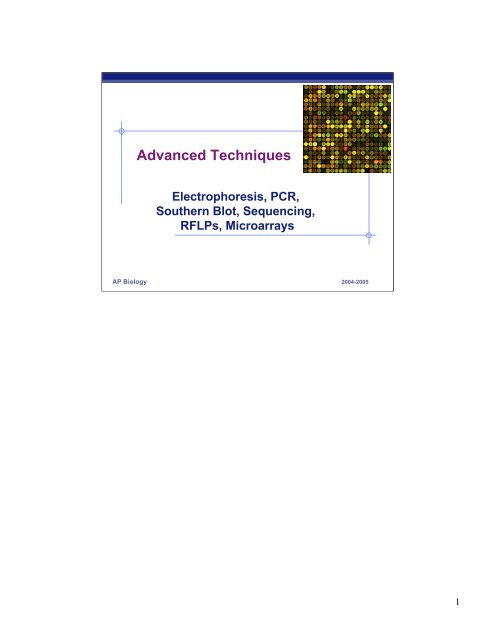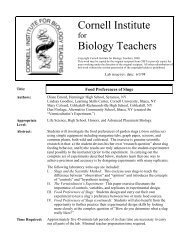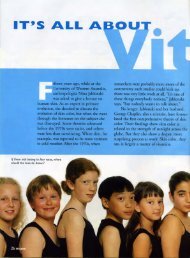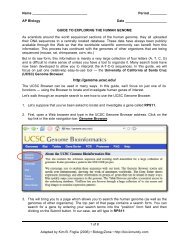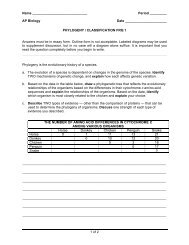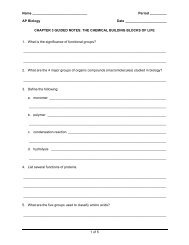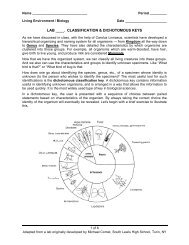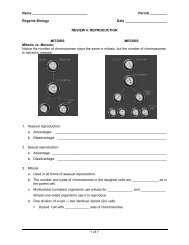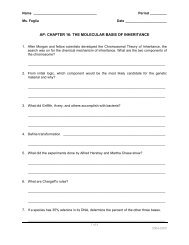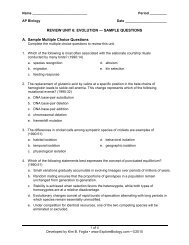Chapter 20: Biotechnology -- Advanced Techniques - Explore Biology
Chapter 20: Biotechnology -- Advanced Techniques - Explore Biology
Chapter 20: Biotechnology -- Advanced Techniques - Explore Biology
Create successful ePaper yourself
Turn your PDF publications into a flip-book with our unique Google optimized e-Paper software.
<strong>Advanced</strong> <strong>Techniques</strong>Electrophoresis, PCR,Southern Blot, Sequencing,RFLPs, MicroarraysAP <strong>Biology</strong><strong>20</strong>04-<strong>20</strong>051
Gel ElectrophoresisAP <strong>Biology</strong><strong>20</strong>04-<strong>20</strong>053
Gel ElectrophoresisAP <strong>Biology</strong><strong>20</strong>04-<strong>20</strong>054
Measuring fragment size compare bands to a known “standard” usually lambda phage cut with HindIII nice range of sizes with a distinct patternAP <strong>Biology</strong><strong>20</strong>04-<strong>20</strong>055
RFLP Restriction Fragment Length PolymorphismAP <strong>Biology</strong> change in DNA sequence affectsrestriction enzyme “cut” site will create different band pattern<strong>20</strong>04-<strong>20</strong>056
Southern Blot Want to locate a sequence on a gel?AP <strong>Biology</strong><strong>20</strong>04-<strong>20</strong>057
Southern blot Transfer DNA from gel tofilter paper hybridize filter paper withtagged probe fragment with matchingAP <strong>Biology</strong>sequence ‘lights up”<strong>20</strong>04-<strong>20</strong>058
Polymerase Chain Reaction (PCR) What if you havetoo little DNA towork with? PCR is a methodfor making manycopies of aspecificsegment of DNA ~only need 1 cellof DNA to startcopying DNA withoutbacteria AP <strong>Biology</strong> or plasmids!<strong>20</strong>04-<strong>20</strong>059
PCR primersAP <strong>Biology</strong> The primers are critical! need to know sequence tomake proper primers primers flank targetsequence start with long piece of DNA © a specified shortersegment primers define section of DNAto be cloned Taq polymerase from hot springs bacteria why do we use it?play DNAi movie<strong>20</strong>-30 cycles3 steps/cycle30 sec/step <strong>20</strong>04-<strong>20</strong>05Taq = Thermus aquaticus (an Archaebactera)Highly thermostable – withstands temperatures up to 95°C for morethan 40min.BTW, Taq is patented by Roche and is very expensive. Its usually thelargest consumable expense in a genomics lab. I’ve heard stories ofcontraband Taq clones, so scientists could grow up their ownbacteria to produce Taq in the lab. It’s like pirated software -- piratedgenes!PCR is an incredibly versatile technique:An important use of PCR now is to “pull out” a piece of DNAsequence, like a gene, from a larger collection of DNA, like the wholecellular genome. You don’t have to go through the process ofrestriction digest anymore to cut the gene out of the cellular DNA. Youcan just define the gene with “flanking” primers and get a lot ofcopies in 40 minutes through PCR.Note: You can also add in a restriction site to the copies of the gene(if one doesn’t exist) by adding them at the end of the original primers.10
1985|1993Kary Mullis development of PCR technique a copying machine for DNAAP <strong>Biology</strong><strong>20</strong>04-<strong>20</strong>05In 1985, Kary Mullis invented a process he called PCR, which solveda core problem in genetics: How to make copies of a strand of DNAyou are interested in.The existing methods were slow, expensive & imprecise. PCR turnsthe job over to the very biomolecules that nature uses for copyingDNA: two "primers" that flag the beginning & end of the DNA stretch tobe copied; DNA polymerase that walks along the segment of DNA,reading its code & assembling a copy; and a pile of DNA buildingblocks that the polymerase needs to make that copy.As he wrote later in Scientific American:"Beginning with a single molecule of the genetic material DNA, thePCR can generate 100 billion similar molecules in an afternoon. Thereaction is easy to execute. It requires no more than a test tube, a fewsimple reagents and a source of heat. The DNA sample that onewishes to copy can be pure, or it can be a minute part of an extremelycomplex mixture of biological materials. The DNA may come from ahospital tissue specimen, from a single human hair, from a drop ofdried blood at the scene of a crime, from the tissues of a mummifiedbrain or from a 40,000-year-old wooly mammoth frozen in a glacier."11
DNA Sequencing Sanger methodAP <strong>Biology</strong> determine thenucleotidesequence of DNA synthesizecomple mentarystrand of DNA invitro use taggedbases ddNTPdideoxynucleotides<strong>20</strong>04-<strong>20</strong>0512
Dideoxynucleotides reagent mix for DNA replication “normal” N-bases dideoxy N-bases missing O for bonding of nextnucleotide terminates chain radioactively tagged DNA polymerase primer buffers & saltAP <strong>Biology</strong>play Sequencing movie<strong>20</strong>04-<strong>20</strong>0513
Reading the sequence Load gel with sequences fromddA, ddT, ddC, ddG in separatelanes read lanes manually & carefully polyacrylamide gelAP <strong>Biology</strong><strong>20</strong>04-<strong>20</strong>0514
Fred SangerThis was his 2nd Nobel Prize!! 1st was in 1958 for theprotein structure of insulin1978|1980AP <strong>Biology</strong><strong>20</strong>04-<strong>20</strong>0515
Advancements to sequencing Fluorescent tagging no more radioactivity all 4 bases in 1 lane each base a different color Automated readingAP <strong>Biology</strong><strong>20</strong>04-<strong>20</strong>0516
Advancements to sequencing Capillary tube electrophoresis no more pouring gels higher capacity & fasterApplied Biosystems, Inc(ABI) built an industry onthese machinesAP <strong>Biology</strong>384 lanes<strong>20</strong>04-<strong>20</strong>0517
Big labs! economy of scalePUBLIC Joint Genome Institute(DOE) MIT Washington Universityof St. Louis Baylor College ofMedicine Sanger Center (UK)PRIVATE Celera AP <strong>Biology</strong> Genomics<strong>20</strong>04-<strong>20</strong>0518
Human Genome Project U.S government project begun in 1990 estimated to be a 15 year project DOE & NIH initiated by Jim Watson led by Francis Collins goal was to sequence entirehuman genome 3 billion base pairs Celera Genomics Craig Venter challenged gov’t would do it faster, cheaper private companyAP <strong>Biology</strong><strong>20</strong>04-<strong>20</strong>051990-1995 build the technology groundwork improve sequencing methods build clones build better data management systems (computer toolsto find overlaps) better, cheaper, faster!1996-1998 painstaking sequencing work1998 Celera genomics challenge<strong>20</strong>00 rough draft of human genome (90% sequence, 99% accurate)<strong>20</strong>01 1st draft of human genome<strong>20</strong>03 “finished” sequence of human genome can’t sequence telomeres & centromeres19
Different approaches“map-based”“shot gun”AP <strong>Biology</strong><strong>20</strong>04-<strong>20</strong>05<strong>20</strong>
Human Genome ProjectOn June 26, <strong>20</strong>01, HGP published the “workingdraft” of the DNA sequence of the humangenome.Historic Event! blueprintof a human the potential tochange science &medicineAP <strong>Biology</strong><strong>20</strong>04-<strong>20</strong>0521
GenBankDatabase ofgeneticsequencesgatheredfromresearchPubliclyavailable!AP <strong>Biology</strong><strong>20</strong>04-<strong>20</strong>0522
The Progress4.E+103.E+103.E+102.E+10first metazoan complete(flatworm)122+ bacterialgenomes2.E+101.E+105.E+090.E+00Dec-82# of DNA base pairs(billions)in GenBankDec-83DataAPfrom<strong>Biology</strong>NCBI and TIGR(www.ncbi.nlm.nih.gov and www.tigr.org )Dec-84Dec-85first eukaryote complete(yeast)First 2 bacterial genomescompleteDec-86Dec-87Dec-88Dec-89Dec-90Dec-91Dec-92Dec-93Dec-94Dec-95Dec-96Dec-97Dec-98Dec-99Dec-00Official “15 year”Human Genome Project:1990-<strong>20</strong>03.Dec-01Dec-02Jun-0317eukaryoticgenomescompleteor nearcompletionincludingHomosapiens,mouse andfruit flyS1<strong>20</strong>04-<strong>20</strong>05In the last 5 years or so the amount of data hasgrown exponentially, including the growth ofonline databases and resources. In this slidewe have the growth of the total number of basepairs and the total number of genomescompleted since the beginning of the HumanGenome Project. As you can see, the sheernumber and growth of this resource has beenimpressive—and daunting—in the last 5 years.Few scientists are aware of, or make full useof, all the open-source and public resourcesavailable to them through the internet. TheAnnual Nucleic Acids Research Databaseissue listing contained 548 databases thisyear!!23
Other genomesAP <strong>Biology</strong><strong>20</strong>04-<strong>20</strong>0524
Microarrays Measuringexpression of genesin a tissue sample samples of mRNAfrom cells make cDNA 2-color fluorescenttagging hybridize to spotsof genes colored spots =gene expression red, green, yellowAP <strong>Biology</strong><strong>20</strong>04-<strong>20</strong>05Developed by Pat Brown at Stanford in late 1980sRealized quickly he needed an automated system: robotspotterDesigned spotter & put plans on Internet for benefit ofscientific community.25
When to use microarrays? Research toolAP <strong>Biology</strong> it’s all about comparisons gene expression…. before vs. after treatment cancer vs. normal cells wound healing vs. scarring stages of development color coding red = expression in 1 sample green = expression in other sample yellow = expression in bothsamples dark = low expression in both<strong>20</strong>04-<strong>20</strong>0526
DNA Chip Patented microarray technology fromAffymetrixAP <strong>Biology</strong> automated DNA synthesis of genes ofinterest on chip chips are more consistent smaller spots/more spotsper chip can buy specific chips human chip mouse chip etc.<strong>20</strong>04-<strong>20</strong>0527
<strong>Biotechnology</strong> today: Applications Application of DNA technologies basic biological research medical diagnostics medical treatment (gene therapy) pharmaceutical production forensics environmental cleanup agricultural applications…and then there’s the ethics issues!AP <strong>Biology</strong><strong>20</strong>04-<strong>20</strong>0528
Application of recombinant DNA Combining sequences of DNA from2 different sources into 1 DNA molecule often from different species human insulin gene in E. coli (humulin) frost resistant gene from Arctic fish instrawberries “Roundup-ready” bacterial gene in soybeans BT bacterial gene in corn jellyfish glow gene inZebra “Glofish”AP <strong>Biology</strong><strong>20</strong>04-<strong>20</strong>05In 1978, scientists at the <strong>Biotechnology</strong> Company, Genentech, clonedthe gene for Human Insulin. Genentech licensed the human insulintechnology to Eli Lilly, where it was named "Humulin" orRecombinant Human Insulin. In 1982, human insulin became thefirst recombinant DNA drug approved by FDA. Today, Humulin ismade in Indianapolis in gigantic fermentation vats, 4 stories high andfilled with bacteria!!! These fermentation vats operate 24 hours a day,year round. The human insulin protein made by the E. coli bacteria iscollected from the vats, purified, and packaged for use by patientswith diabetes.29
What next? After you have cloned & amplified DNA(genes), you can then tackle moreinteresting questions how does gene differ from person toperson? …or species to species is a certain allele associated with ahereditary disorder in which cells is gene expressed? where is gene in genome?AP <strong>Biology</strong><strong>20</strong>04-<strong>20</strong>0530


